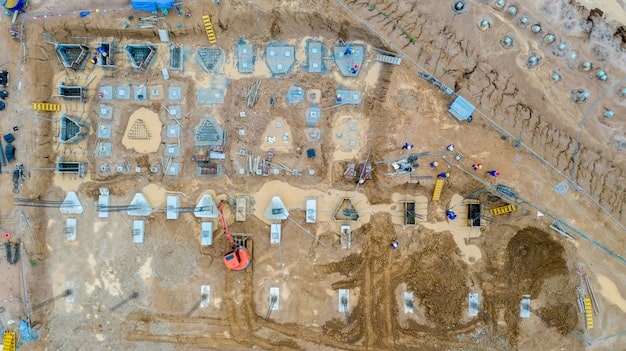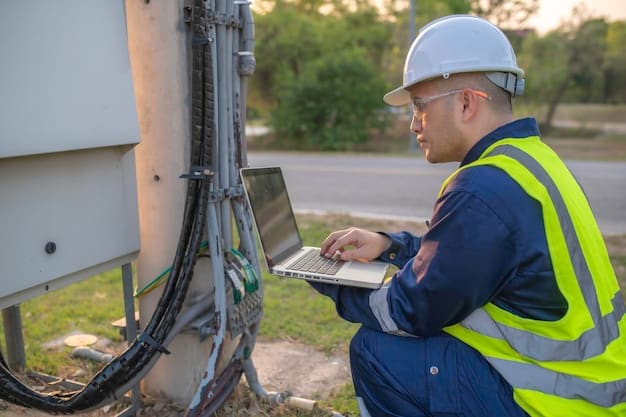Infrastructure Investment Plan: Projecting the US Economy by 2030

By 2030, the government’s infrastructure investment plan is projected to stimulate economic growth, create jobs, improve productivity through modernized infrastructure, and potentially reduce income inequality by providing opportunities in underserved regions.
The projected outcomes of the government’s infrastructure investment plan on the US economy by 2030 are multifaceted, touching everything from job creation and GDP growth to productivity enhancements and regional development.
Understanding the Infrastructure Investment Plan
The Infrastructure Investment and Jobs Act, a bipartisan effort, represents a significant commitment to modernizing America’s infrastructure. It allocates billions of dollars to address long-neglected needs across various sectors.
This plan aims to not only repair and upgrade existing infrastructure but also to invest in future technologies and sustainable solutions. It is designed to enhance the nation’s competitiveness and improve the quality of life for all Americans.

Key Components of the Plan
The plan encompasses a wide range of projects, including:
- Transportation: Funding for roads, bridges, public transit, and airports.
- Utilities: Upgrades to water pipes, energy grids, and broadband internet access.
- Environmental Remediation: Investments in cleaning up polluted sites and addressing climate change resilience.
These components are interconnected and designed to work together to create a more efficient and sustainable infrastructure system.
The impact of this plan is expected to be felt across all sectors of the economy, creating opportunities for businesses and individuals alike.
In conclusion, the Infrastructure Investment Plan is a comprehensive initiative that seeks to modernize the US infrastructure and create a more prosperous future for the nation.
Job Creation and Economic Growth
One of the primary goals of the infrastructure plan is to stimulate job creation and boost economic growth. The sheer scale of the projects involved is expected to generate numerous employment opportunities across various skill levels.
Beyond direct construction jobs, the plan is also expected to create indirect jobs in supporting industries such as manufacturing, transportation, and logistics.
Direct and Indirect Job Creation
The plan is projected to create millions of jobs, both directly and indirectly. These jobs will be in:
- Construction: Building and repairing roads, bridges, and other infrastructure.
- Manufacturing: Producing the materials and equipment needed for construction projects.
- Services: Providing support services such as engineering, design, and project management.
This influx of jobs is expected to lower unemployment rates and increase household incomes, leading to greater consumer spending.
Furthermore, the plan is expected to attract private investment, further amplifying its economic impact. Businesses will be more likely to invest in areas with modern and reliable infrastructure.
In summary, the infrastructure plan is poised to be a significant driver of job creation and economic growth, benefitting individuals, businesses, and the nation as a whole.
Productivity and Efficiency Gains
Modernizing infrastructure is expected to lead to significant gains in productivity and efficiency across various sectors. Upgrading transportation networks, for example, can reduce transportation costs and improve supply chain efficiency.
Similarly, investing in broadband internet access can improve communication and collaboration, enabling businesses to operate more efficiently. These improvements can result in higher profits and increased competitiveness.

Impact on Key Sectors
The infrastructure plan is expected to have a transformative impact on key sectors of the economy, including:
- Manufacturing: Improved transportation networks can reduce shipping costs and improve access to markets.
- Agriculture: Upgraded water infrastructure can improve irrigation and increase crop yields.
- Energy: Modernized energy grids can improve reliability and reduce energy costs.
These improvements can lead to lower prices for consumers and greater profits for businesses, further stimulating economic growth.
In addition, the plan is expected to foster innovation and entrepreneurship, as businesses take advantage of the new infrastructure to develop new products and services.
In conclusion, the Infrastructure Investment Plan is expected to yield significant productivity and efficiency gains, making the US economy more competitive and resilient.
Regional Development and Income Inequality
Another important goal of the infrastructure plan is to promote regional development and reduce income inequality. By investing in underserved regions, the plan can create opportunities for residents and businesses in those areas.
These investments can help to attract new businesses, create jobs, and improve the quality of life for residents. This can lead to greater economic opportunity and reduced income inequality.
Targeted Investments in Underserved Areas
The plan includes provisions for targeted investments in underserved areas, including:
- Rural Communities: Upgrading infrastructure in rural areas can improve access to healthcare, education, and employment opportunities.
- Low-Income Neighborhoods: Investing in infrastructure in low-income neighborhoods can create jobs and improve the quality of life for residents.
- Tribal Lands: Addressing infrastructure needs on tribal lands can promote economic development and improve the well-being of Native American communities.
These targeted investments can help to bridge the gap between rich and poor and create a more equitable society.
Furthermore, the plan can help to diversify the economy and reduce reliance on traditional industries, making the US economy more resilient to economic shocks.
In summary, the Infrastructure Investment Plan is a powerful tool for promoting regional development and reducing income inequality, creating a more inclusive and prosperous society.
Potential Challenges and Mitigation Strategies
While the infrastructure plan holds great promise, there are also potential challenges that need to be addressed. These challenges include rising construction costs, supply chain disruptions, and workforce shortages.
To mitigate these challenges, policymakers and industry leaders need to work together to develop effective strategies. These strategies may include:
Addressing Potential Roadblocks
Several challenges could hinder the successful implementation of the infrastructure plan, including:
- Rising Construction Costs: Inflation and supply chain disruptions can drive up construction costs, making projects more expensive.
- Workforce Shortages: A shortage of skilled workers can delay projects and increase labor costs.
- Regulatory Hurdles: Complex permitting processes and environmental regulations can slow down project approvals.
These challenges need to be addressed proactively to ensure that the plan is implemented effectively and efficiently.
To address these challenges, it is crucial to invest in workforce training programs, streamline permitting processes, and promote innovation in construction technologies.
In conclusion, while there are potential challenges to overcome, proactive mitigation strategies can help to ensure that the Infrastructure Investment Plan achieves its goals and delivers lasting benefits to the US economy.
Long-Term Economic Outlook
Looking ahead to 2030, the long-term economic outlook for the US economy is expected to be positively influenced by the infrastructure investment plan. The plan is expected to contribute to sustained economic growth, increased productivity, and improved competitiveness.
However, the actual impact of the plan will depend on a variety of factors, including the effectiveness of implementation, the state of the global economy, and the evolving technological landscape.
Forecasting the Future
The long-term economic outlook for the US economy is contingent on several factors:
- Global Economic Conditions: A healthy global economy can boost US exports and attract foreign investment.
- Technological Innovation: Advancements in technology can drive productivity growth and create new industries.
- Policy Decisions: Sound fiscal and monetary policies can promote economic stability and sustainable growth.
Considering these factors, it is reasonable to expect that the Infrastructure Investment Plan will contribute to a more prosperous and resilient US economy by 2030.
By investing in infrastructure, the US can lay the foundation for long-term economic success and improve the quality of life for all Americans.
In summary, the long-term economic outlook for the US economy is positive, with the Infrastructure Investment Plan playing a crucial role in shaping a brighter future.
| Key Point | Brief Description |
|---|---|
| 👷 Job Creation | Millions of jobs created in construction, manufacturing, and services. |
| 📈 Economic Growth | Stimulation of GDP through infrastructure projects and related investments. |
| ⚡ Productivity Gains | Improved efficiency due to modernized transportation and utilities. |
| 🏘️ Regional Development | Investment in underserved areas to reduce income inequality. |
FAQ Section
▼
The main goal is to modernize and improve US infrastructure, enhancing economic growth, creating jobs, and improving the quality of life.
▼
The plan is projected to create millions of jobs across various sectors, including construction, manufacturing, and services.
▼
Key sectors include transportation, utilities, energy, manufacturing, agriculture, and broadband internet access.
▼
By targeting investments in underserved regions, the plan aims to create opportunities and improve living standards in those areas.
▼
Potential challenges include rising construction costs, workforce shortages, and regulatory hurdles that could delay progress.
Conclusion
In conclusion, the government’s Infrastructure Investment Plan is poised to have a significant and lasting impact on the US economy by 2030. By addressing critical infrastructure needs, the plan is expected to stimulate economic growth, create jobs, improve productivity, and reduce income inequality. While challenges remain, proactive mitigation strategies can help to ensure that the plan achieves its goals and delivers a brighter future for the nation.





